Buddy Selfish & His Saviours - A Taco On The Barber Chair
Wednesday, May 07, 2008
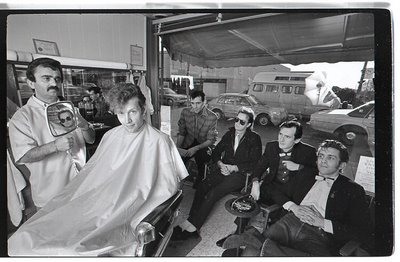
I know very few people in Vancouver who have a memory for buildings that are gone or for buildings that have been modified. A pleasant exception is my friend architect Henry Hawthorn.
Few who might find themselves at the corner of Fir and West Broadway would suspect that the strange white building that is now the Filpino bakery Goldilocks (the largest bakery chain in the world), used to house est (Erhard Seminars Training). Encounter sessions would be far livelier with Magnolia macapunú ice cream on the side.
In 1982 I photographed a revival rockabilly band Buddy Selfish & His Saviours in what for many years seemed to be a permanent fixture of our city. An Italian gentleman (an Italian version of Dorian Gray as he always looked the same) had a barbershop on the corner of Commercial Drive and 1st Avenue. Perhaps only two or three years ago it became a Mexican fast food restaurant (a very good one).
When I stop at this corner I think of the Ian Tiles (sitting on the barber chair) and the other members of the band. On the far right is Colin Griffiths (ex-UJ3RK5), then Bob Petterson, Nick Jones (ex-Pointed Sticks) and Andy Grafitti (ex-UJ3RK5).
Karethe Linnaae - Knife Out Of Water
Tuesday, May 06, 2008
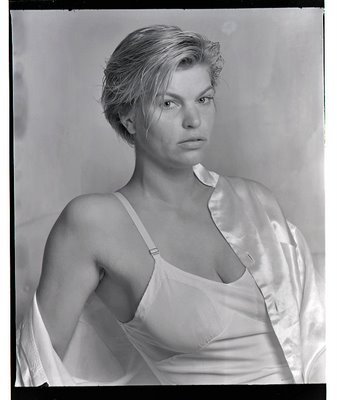 Some years ago I read a book of short stories by Milan Kundera. One of the stories has remained in my memory. A young married couple living in the former Eastern Block country in Europe have to plan their vacation ahead. They finally get permission and they are driving to their resort destination. They are slightly bored so the woman suggests that they stop for gasoline and play a game. He is to gas up and then she will walk further on a pretend that she is thumbing a ride. He agrees. He picks her up and the game gets vicious when they say things to each other that they would otherwise have never said. He thinks she plays too easy, she thinks he is a sexist pig. That story has remained in my memory because I associate it with a Polanski's classic 1962 film Knife in the Water. I saw it in the Israeli Cultural Institute in Mexico City sometime in 1964. In this film a couple on their way to a weekend escape in their boat, pick up a male hitchhiker and invite him to their boat. A rivalry insues for the attentions of the woman. There is something European about the story and the film. While I have seen every film Charlotte Rampling (the quintessential European woman) I thought she was a fish out of water in the 1982 American film The Verdict with Paul Newman. Her "Europeaness" was diluted. 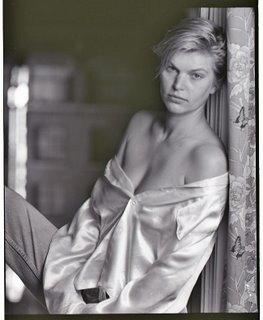 Norwegian film lighting technician Karethe Linnaae oozes European. Her accent is just right and her voice low enough to instantly alert you to her presence. She is the kind of woman that if you invite her to a bar/restaurant (the Railway Club on Dunsmuir, for example) men (and women) will ask me, "Who is she?" I can imagine a knife fight over her and Kundera would write a story about Karethe if he ever met her. He would write how she is a wrench in any mixture of men and how they will abandon all pretenses of fair play and gentlemanly behaviour to attract her attention. 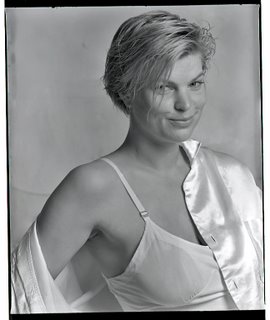 While I have not seen her for a long while I remember her easy smile and her warmth. I am grateful to have met her.
Monday, May 05, 2008
 It appreared in about 1941, raised by Colonel Stevenson Clark of Sussex, England, by crossing Camellia saluenensis with Camellia japonica ’Masayoshi’ I have written about camellias and this particular one here. When I look at camellias I think of my boarding school days at St. Edwards in Austin, Texas in the late 50s. The only woman on campus was an older and large black woman who worked in our cafeteria kitchen. Our only contact with members of the female sex where in the basketball and football games. The girls from the other side of the city, St Mary's attended and some of them were our cheerleaders. I was much too shy to talk to them (and Judy Reyes, below, in particular) and since I didn't know how to dance I rarely met any of them at our occasional sock hops in our basketball gym. 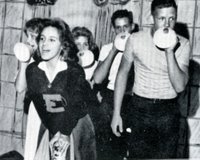 There was one woman (there were others, but I remember in particular this one) who knew the number of our pay phone at the end of our dormitory hall. Her name was Marion and she would call and we would talk to her for hours. She led us on (I would use a the term that was in vogue then, she was a p---- teaser ). She had a pleasant sexy voice and was never crude. She was a solace in those in-between days before they let us out for all day passes in town on Saturdays and Sundays. I would first go to 6th Street where there was a pocket book store. After buying a Frank G. Slaughter pocket novel. The medical novels had lots of terrific sex in them. I did not feel guilty in reading them as my mother loved this author. And one title in particular, Dear And Glorious Physician was about St Luke even though there were lots of sexual shenanigans in Bithynia! Then I would walk to the Stephen F. Austin Hotel on Congress Avenue and I would gaze (while spooning my favourite ice cream, vanilla with real cherry bits) on the lovely soda jerk who worked behind the soda fountain counter. She was blonde and I imagined she was Eva Marie Saint. I had fallen for her (and ignored Elizabeth Taylor's violet eyes) when I had seen Raintree County in the movie house, next door. Camellias are like Marion and the soda jerk at the Stephen F. Austin. They dazzle, they promise but don't deliver. Camellias have all the promise of my roses that begin to bloom at the end of May. Some of my roses even resemble camellias. But they also deliver with scent. Many are remontant and don't just bloom and quickly fade away as camellias do. But my camellias do offer me solace for those in-between days of May. Before my roses finally deliver.
Trampling Huns & Little Girl Hostesses
Sunday, May 04, 2008
 One of the perils of opening one's garden to a tour is that even if I tell Rosemary that nobody is going to bother to look at the outside of the house she worries that people will do just that. Since we moved to our house on Athlone Street in 1986 we have only had our house painted once. And it was a nerve racking experience. The only way you can paint our house is to do so in the waning days of summer, after we simply say to ourselves, "Let the painters step on anything. The plants will come back next year." To paint our house or even approach a cosmetic "paint the flaws" approach now is at best a compromise. These cosmetic touches cannot be applied until the weather is warm enough and dry enough for the paint to stick. This means the plants (including delicate ferns and emerging hostas) will suffer the fearsome effects of our local Attilas who have no idea of their fragile nature. Yesterday was one of the most stressful days in memory for us as our Bosnian Attila trampled back and forth while painting with finesse the peeling stucco that had been "gently" removed by his German Attila cohort with 2200psi. To be fair no painter that I know would have accepted such a job that involved placing ladders in almost dangerous angles when scaffolding should have been erected. Worst of all we could not spend much time with Rebecca who given no direction will end up dressing dolls on the computer or watching TV. Lauren, on the other hand stayed outside talking to our Bosnian Attila. He talks even when we are not nearby. Here he finally found his match and he warmed up to her. Considering that he is poised to be a grandfather by December this bodes well. He is gentle with children even if with us he complains of the working conditions, the cold , the rain and our impossible demands. Lauren spent the day outside while asking me questions on absolutely everything. I kept thinking while showing much patience and restraint, "Go and talk to him." But both Rosemary and I know that when the visitors from the home and gardens (one garden, ours!) Ballet BC tour come at the end of the month the garden will be as ready as it can possibly be. Both Rebecca and Lauren will be wearing dresses and, if weather permits, they will be barefoot. I will teach Lauren the names of some plants (Rebecca knows many already) and they will be our hostesses while se sit down and enjoy the hordes of visitors (anywhere between 1500 and 2000). Stressful times will be in the past and even though Rosemary said, "Never again," I am sure that if someone calls to ask us if we will open the garden next year...
C.C. Humphreys - Absolute Sword Player
Saturday, May 03, 2008
 I have been re-reading Alexandre Dumas to satisfy my appetite for swashbuckler novels. Then I discovered Jack Absolute. Former actor, schoolboy fencing champion and author (six novels and three plays) C.C. Humphreys was a few minutes late to my studio. He had decided to drive not walk. He was concerned he might be stopped on the way. He was bringing a cavalry sabre. In 1987 in the opening night of the eighteenth-century comedy, Richard Sheridan's The Rivals in London, actor Humphreys played protagonist Jack Absolute, a young swashbuckler rake. In Humphreys 2003 novel, Jack Absolute , Jack goes to see the The Rivals and learns that Sheridan has stolen his name and made him the star of his comedy. In Humphreys's third in the series, Absolute Honour (2006, the second was the 2004 prequel The Blooding of Jack Absolute ) Humphreys borrows back from Sheridan and incorporates part of the plot of The Rivals. Canadian born, but British educated, Humphreys understands the importance of the Plains of Abraham in the making of Canada. In The Blooding of Jack Absolute Jack is a 16-year-old boy who fights in that battle. During his research Humphreys climbed up that back way to the Quebec City plains in training shoes. "It's not vertical but at 70 degrees it must have been difficult. Every time you place your foot it is treacherous and you slip. What would it have been like in boots, pack and musket? At the top there are two signs. The one in English stated that this was the path the British Light Infantry came up at two in the morning. The one in French hints that Wolfe snuck up and with superior naval power won the day. Which is bonks! The navy was not involved." Humphreys the actor became obsessed with Absolute to create the protagonist of his novels. He also has played Hamlet enough times to find an equal attraction to the role. Of Hamlet he said to me, "It is the ultimate straight role. Whatever stuff you bring from your life, that's who Hamlet is on stage. It is a personal journey. It exposes a lot of your own things and stuff." In the Blooding of Jack Absolute Jack winters in a cave with a Mohawk called Até. He teaches him to read with the only book in hand, a cheap copy of Shakespeare's tragedy. With lots of twists and turns, spies and sword fights(complex ones involving left handers), Humphreys satisfies my hunger for reading adventure. Now as a late Canadian citizen, I understand how the battle that made Canada was fought. I asked Humphreys what role a swachbuckler plays in the 21st century. "It is as ever it was. It is to give an example of someone who is engages in the pursuit of honour, justice and is prepared to risk all at the point of a sword to gain everything." 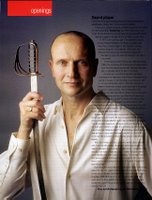 Humphreys has also published the novel The French Executioner (about the man who lopped off Anne Boleyn's head). For those who cannot wait for the next Jack Absolute they will have to wait longer. In October 2008 McArthur & Co. will be publishing Humphrey's novel about the true historical Dracula, Vlad: The Last Confession. Humphreys lives in Vancouver whith his wife and son. His website is: cchumphreys.com © 2008 VLM/Alex Waterhouse-Hayward
Tuesdays With Morrie - The More Than Human Jazz Pianist
Friday, May 02, 2008
Rosemary and I attended last night the opening performance of Mitch Albom and Jeffrey Hatcher's play Tuesdays with Morrie. It was an Arts Club Theatre Production on the Granville Island Stage. It was an exquisitely excruciating experience.
It was that much more excruciating for me because I had the pleasure of taking Antony Holland's (he plays Morrie to Warren Kimmel's Mitch) portrait, left, last Thursday. Holland was 88 on March 28th. When he faced my camera it was obvious that here was a man who is in full control of all of his faculties including a keen sense of humour and a phenomenal memory. The only flaw I could detect was an extraordinary sweet tooth. He is much younger than his 88 years.
To see Holland's character Morrie (who is suffering the terminally degenerative Lou Gehrig's disease) break down on stage and slowly descend from dancing, to using a walker, to sitting in a wheel chair, to having to use a reclining sofa and then further degenerating into the pallid emaciated old man who is bedridden was a tour the force for me.
This tour de force was equaled by Warren Kimmel's performance as an ambitious, cold, calculating sports writer who somehow by the end of the play breaks down (pushed by his mentor Morrie) and becomes a whole human being. He was so despicable that I even noticed his loathsome light brown Italian shoes. Had I met him on the street with him wearing those shoes I would have instantly disliked him. Such is the power of good acting.
Such is the power of good acting that the play brought to mind a favourite science fiction novel that I had read in the 60s called More Than Human by Theodore Sturgeon. Somehow as Mitch broke down mentally while his mentor Morrie broke down physically that combination added to "more than human" and gave this depressing play (I laughed lots in the first act) a cathartic saving grace.
Curiously a play with such complexity of feelings had friend and VLM editor Bob Mercer and I wondering if Warren Kimmel was really playing that wonderful jazz piano. Mercer who probably told both his younger brothers that Santa Claus did not exist thought the piano playing was a recording. I was convinced that Kimmel's considerable acting abilities included playing a damn good jazz piano. So we asked an usher who told us, "I really was not here during the first 15 minutes (a patent lie) so I don't know. Kimmel is talented so he certainly could have been playing it." I was not satisfied so while waiting back stage to talk to Holland I asked the stage manager who answered, "I really cannot tell you as I have not noticed if he plays the piano. It is possible."
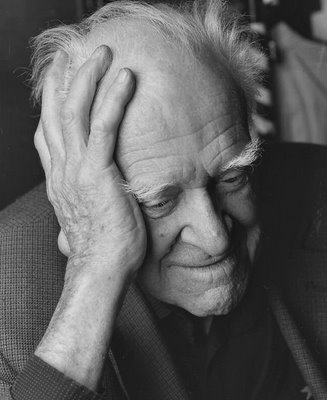
So I warned Holland how the two previous persons had been ambiguous in answering my question. I asked, "Does Kimmel really play that piano?" Holland looked at me directly (and in character, or was it out of character? I could not make up my mind.) and he told me.
Emily Molnar, Crystal Pite - Eisteinian Space & Time
Thursday, May 01, 2008
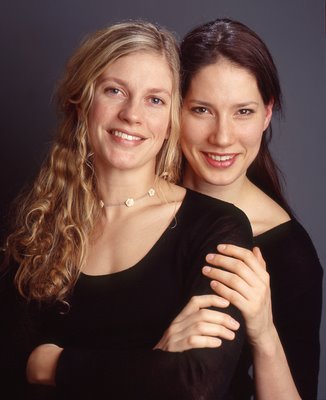 It has taken 65 years for my concept of space and time to change, even after having read here and there about Einsteinian time and space. It all suddenly changed for me some five years ago when Vancouver contemporary dancers Emily Molnar and Crystal Pite discussed space, time and movement in my studio. The shortest definition of relativistic movement I have ever heard came from Molnar (35) who said, “Movement is the observer.” This means that from a position of rest we the observers can discern the movement of a dancer on stage. Of time Pite (37) said, “The ephemeral of dance exists only in the present movement. We are left with traces of movements that are gone as they are being created. As we carve space with our bodies they leave a ghost, the trail which affects our future moves and informs the observer of our past moves.” I then understood that those past moves are much like the contrails that high-flying jets leave in the sky. In 1996 I photographed Crystal Pite who was leaving Ballet BC for William Forsythe’s Frankfurt Ballet. I had seen her Ballet BC farewell performance of her own work, Moving Day. I was amazed by her elegance and style but immediately saddened that I might not to see her dance again. In 1998 I photographed Emily Molnar who returned from the Frankfurt Ballet to assist John Alleyne’s direction of Ballet BC. Fortunately for us all Alleyne made her dance, too. In between, Pite and Molnar met and danced for two years in Frankfurt. Pite returned to Vancouver 6 years ago where she directs Kidd Pivot, her own dance company. Rebecca, my precocious 10 year-old granddaughter with whom I attend as many ballet and modern dance performances as we can, may be well ahead of her lumbering grandfather. She has declared to me that her favourite Vancouver dancers are Crystal and Emily. We agree. It was with Rebecca that I saw Pite do part of her full-length ballet for the Frankfurt Ballet called Field Fiction. On stage, assisted by the excellent Cori Caulfield, and dressed in a stylized military uniform she removed her Prussian type spiked helmet and inserted her head into a noose that hung from the ceiling. On her tiptoes she did an exquisite and alternately horrific interpretation of a man hanging. I can only imagine what the scope of the silence that followed this performance must have been when it premiered in Frankfurt. Behind me was Sylvain Senez, Ballet BC’s Ballet master whispered in my ear, “Crystal is the future of dance in Vancouver.” When Molnar (she is striking at 5 ft 11in) entered my studio for her first picture in 1998 she quietly sat in a corner in a fetal position for 10 minutes before facing my camera. Since then, thanks to Molnar, Pite and the performances of some of William Forsythe’s works by Ballet BC I have come not only to appreciate why Forsythe’s choreography and his company were rated about best in the world but also why Molnar and Pite talk physics. Asked on how he pushes the boundaries of the form of dance Forsythe once said, “I don’t think so much of the body when we are doing this. We are thinking about ‘the thinking body’ or we’re trying to understand how the body thinks about its own presence.” Or the way the ever-succinct Molnar put it to me, “Dance requires the entire body and the mind.” Molnar has her own company, Emily Molnar Dance. When possible I attend whatever performance of hers I can find. More often than not she is busy choreographing for companies in Europe and New York. I sometimes catch her rehearsing the senior dancers at Arts Umbrella on Saturdays. Her principal role performances for several of John Alleyne’s full-length works including The Faerie Queen and Scheherazade linger in my memory. On the rehearsal of the latter Rebecca first noticed her and insisted on meeting her. It was in Molnar’s solo performance of Speak choreographed for her by Margie Gillis that I finally fell hard for her. I had to photograph Molnar for a local publication and she offered to go through the whole performance (just for me!) so I could pick a dance move for the photograph. In such close proximity I learned how strenuous dance really is no matter how effortless a dancer makes it seem to be. I now sit in the front row for dance performances, as part of the rewards of watching dance is to be able to hear the dancers breathe. In retrospect when I think of Molnar and Speak and watching her long limbs I smile remembering what Pite says of her, “There is always this extreme quality of her movement. The extreme doesn’t come from her extremities, although the result is extreme. The extremity is internally motivated. The motivation comes from her core.” For me watching Pite or Molnar dance (they have yet to dance together in Vancouver) puts other dancers with them at a disadvantage. Pite and Molnar stand out and the others just fade much in the same way as the Royal Winnipeg Ballet’s dancers used to disappear for me when I watched Evelyn Hart dance. The uniqueness of Pite’s and Molnar’s style is perhaps best explained by Molnar’s take on Pite. "She is an artist of the highest caliber. She is defining dance in the future. She has a movement understanding that is absolutely three-dimensional. You know it’s Crystal when she dances, whether you see her face or not. There is uniqueness, creativity and a sense of humour in her statements. There is a grounded articulation in her physicality. There is no one like Crystal, and what that is, is still evolving." While Crystal’s definition of Molnar involves lots of physics I can safely say that Sylvain Senez was only half right. The future of dance in Vancouver is not only Crystal Pite but Emily Molnar, too. It is a special delight when either Molnar or Pite appear in one of my favourite Vancouver dance programs, Dances for a Small Stage . The restraints of a small stage are a problem when you consider that both Pite and Molnar agree that when you, for example, throw an arm out, the distance cast is infinite. For a while, I selfishly hope, that their movements do not exceed beyond the borders of our fair and doubly lucky Vancouver.
|


















